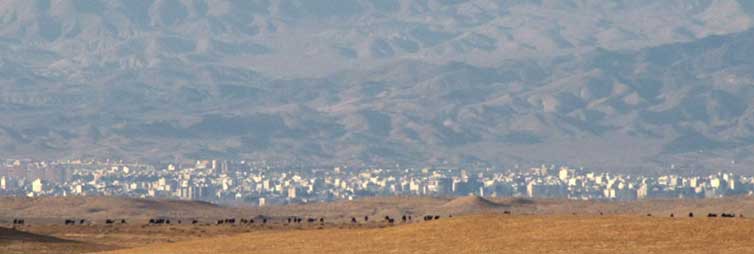Location: Middle East, bordering the Gulf of Oman, the Persian Gulf, and the Caspian Sea, between Iraq and Pakistan
Geographic coordinates:
32 00 N, 53 00 E
Map references:
Middle East
Area:
total: 1,648,195 sq km
land: 1,531,595 sq km
water: 116,600 sq km
country comparison to the world: 18
Area – comparative:
almost 2.5 times the size of Texas; slightly smaller than Alaska
Area comparison map:
Land boundaries:
total: 5,894 km
border countries (7): Afghanistan 921 km, Armenia 44 km, Azerbaijan 689 km, Iraq 1,599 km, Pakistan 959 km, Turkey 534 km, Turkmenistan 1,148 km
Coastline:
2,440 km; note – Iran also borders the Caspian Sea (740 km)
Maritime claims:
territorial sea: 12 nm
contiguous zone: 24 nm
exclusive economic zone: bilateral agreements or median lines in the Persian Gulf
continental shelf: natural prolongation
Climate:
mostly arid or semiarid, subtropical along Caspian coast
Terrain:
rugged, mountainous rim; high, central basin with deserts, mountains; small, discontinuous plains along both coasts
Elevation extremes:
lowest point: Caspian Sea -28 m
highest point: Kuh-e Damavand 5,671 m
Natural resources:
petroleum, natural gas, coal, chromium, copper, iron ore, lead, manganese, zinc, sulfur
Land use:
agricultural land: 30.1%
arable land 10.8%; permanent crops 1.2%; permanent pasture 18.1%
forest: 6.8%
other: 63.1% (2011 est.)
Irrigated land:
87,000 sq km (2009)
Total renewable water resources:
137 cu km (2011)
Freshwater withdrawal (domestic/industrial/agricultural):
total: 93.3 cu km/yr (7%/1%/92%)
per capita: 1,306 cu m/yr (2004)
Natural hazards:
periodic droughts, floods; dust storms, sandstorms; earthquakes
Environment – current issues:
air pollution, especially in urban areas, from vehicle emissions, refinery operations, and industrial effluents; deforestation; overgrazing; desertification; oil pollution in the Persian Gulf; wetland losses from drought; soil degradation (salination); inadequate supplies of potable water; water pollution from raw sewage and industrial waste; urbanization
Environment – international agreements:
party to: Biodiversity, Climate Change, Climate Change-Kyoto Protocol, Desertification, Endangered Species, Hazardous Wastes, Marine Dumping, Ozone Layer Protection, Ship Pollution, Wetlands
signed, but not ratified: Environmental Modification, Law of the Sea, Marine Life Conservation
Geography – note:
strategic location on the Persian Gulf and Strait of Hormuz, which are vital maritime pathways for crude oil transport[/one_half][/columns]

